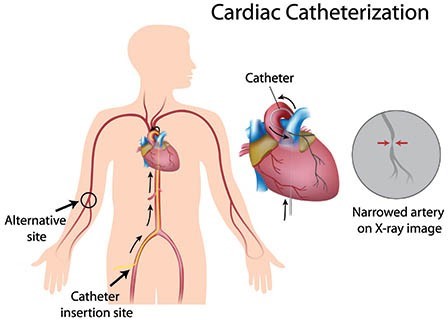A nurse is providing preoperative teaching for an adolescent who is scheduled for a cardiac catheterization. Which of the following instructions should the nurse include?
You can resume a regular diet 3 days after your procedure.
You can take a shower 1 day after your procedure.
You can begin exercising 2 days after your procedure.
You can return to school 1 week after your procedure.
The Correct Answer is B
Answer: B. You can take a shower 1 day after your procedure.
Rationale:
A. You can resume a regular diet 3 days after your procedure:
There is typically no need to delay resuming a regular diet for three days after a cardiac catheterization. Most clients can resume their usual diet shortly after the procedure once they are fully awake and any nausea has resolved.
B. You can take a shower 1 day after your procedure:
It is generally safe to shower the day after a cardiac catheterization as long as the insertion site remains protected. Clients should avoid soaking in a bath or swimming until the site is fully healed to prevent infection.
C. You can begin exercising 2 days after your procedure:
Strenuous activities, including exercise, should generally be avoided for a few days to a week following a cardiac catheterization. This allows time for the insertion site to heal and reduces the risk of complications such as bleeding.
D. You can return to school 1 week after your procedure:
Most clients can return to school or normal activities within a few days, provided they feel well and avoid excessive physical exertion. A full week off is typically not necessary unless specified by the healthcare provider based on the individual’s recovery.

Nursing Test Bank
Naxlex Comprehensive Predictor Exams
Related Questions
Correct Answer is C
Explanation
Answer: C
Rationale:
A) Encourage strength-training exercise: Strength-training exercises can be beneficial in building muscle mass and improving overall strength. However, for a client with leukemia experiencing chronic fatigue, this may be too strenuous and could exacerbate their fatigue rather than alleviate it. It is better to encourage light to moderate activities based on their tolerance.
B) Increase the client's fluids to 4 L per day: While adequate hydration is important, increasing fluids to 4 L per day may not be suitable for all clients and could pose risks, particularly if there are concerns about fluid balance or renal function. This recommendation should be tailored to the client's specific needs and medical condition.
C) Increase protein in the diet: Increasing protein in the diet can help improve energy levels and support the body's repair and regeneration processes. For clients with leukemia who are experiencing chronic fatigue, a high-protein diet can aid in maintaining muscle mass and overall nutritional status, helping to combat fatigue.
D) Encourage the client to have continual bed rest: Encouraging continual bed rest can lead to deconditioning and further exacerbate fatigue. It is important to balance rest with periods of gentle activity to maintain some level of physical function and avoid complications such as muscle atrophy or deep vein thrombosis.
Correct Answer is C
Explanation
The charge nurse should remind the newly licensed nurse that the client has a right to refuse medication. It is important for healthcare providers to respect the autonomy and rights of their clients, including the right to refuse treatment.
Option a is incorrect because it may not be appropriate for the family to persuade the client to take medication against their wishes.
Option b is incorrect because delivering medication intramuscularly against the client's wishes would violate their right to refuse treatment.
Option d is incorrect because inquiring about compatible foods with the pharmacy would not address the issue of the client's right to refuse medication.
Whether you are a student looking to ace your exams or a practicing nurse seeking to enhance your expertise , our nursing education contents will empower you with the confidence and competence to make a difference in the lives of patients and become a respected leader in the healthcare field.
Visit Naxlex, invest in your future and unlock endless possibilities with our unparalleled nursing education contents today
Report Wrong Answer on the Current Question
Do you disagree with the answer? If yes, what is your expected answer? Explain.
Kindly be descriptive with the issue you are facing.
